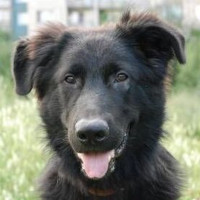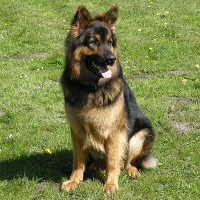Appearance of the New Shep
|
| The New Shep is generally a very big dog, often venturing into the realm of giants, a robust dog with heavy bones and an athletic build. There are certainly differences from dog to dog when it comes to New Shep hybrids, while both parent breeds have straight, strong backs that are slightly longer than the dogs are tall, the Newfoundland Dog's back is generally level while the modern German Shepherd's back often has a decidedly sloping back, especially those that come from dog show lines, and the Newfoundland Dog has a much deeper chest and wider skull. The German Shepherd Dog's muzzle is longer and more tapered than that of the Newfoundland Dog, and although they generally have brown eyes and pointed ears, the Newfoundland Dog's eyes are generally smaller and not as almond-shaped as the German Shepherd Dog's, and the German Shepherd Dog's ears are erect, whereas the Newfoundland Dog's ears fold forward. Both the German Shepherd and the Newfoundland have a double coat, with a soft, dense undercoat and a coarse outer layer of short to medium fur that is usually slightly wavy, and this is usually passed on to their offspring as well. New Shep crosses can inherit physical traits from either of the parent breeds, so even puppies from the same litter can vary considerably in appearance. |
Temperament of the New Shep
|
| In most cases, the combination of these dogs will produce a confident, well-mannered dog, big enough to intimidate, but usually with an approachable manner. However, there are German Shepherd and Newfoundland lines that can develop anxiety, shyness and aggression. It is therefore essential to ensure the good health and temperament of both parents with this cross. Although all interactions between dogs and young children must be carefully monitored, these powerful dogs are generally tolerant of children and often have a calmer temperament than many other dogs of their size, and are less likely to cause bumps and bruises from over-exuberant behavior. They tend to get on well with other pets in the home if socialized early on, and although they are not overly gregarious with other dogs, most dog-to-dog interactions are likely to be good-natured, although same-sex aggression does occasionally occur, particularly in male dogs. Good socialization can also help prevent the formation of some of New Shep's more negative behavioral traits, as can early and advanced training sessions. Training is not easy with these dogs as they are likely to have a little independence, but when engaged, they are extremely trainable dogs and can excel at learning a variety of skills such as advanced obedience training, military and rescue work, tracking, and pulling small carts and sleds. |
Needs and activities of the New Shep
|
| German Shepherds and Newfoundlanders are known for their stamina and strength, and like their parents, New Sheps require daily exercise to maintain these qualities. To stay fit and healthy, these dogs need at least one hour of vigorous activity a day. It's important to remember not to allow growing dogs of this size to exercise or play too roughly, or to jump from high surfaces, as these activities can sometimes cause irreversible damage to rapidly growing bones and joints. This crossbreed is both too active and too large for most apartments, and is better suited to a larger home with a yard. |
Maintenance of the New Shep
|
| Although this particular hybrid doesn't need to be bathed too frequently, the New Shep's coat does require significant effort on the part of the owner to keep it free of dirt, debris and tangles. Not only does the soft undercoat tend to tangle, but the Newfoundland Dog has a coat that seems to attract dust and debris, and the German Shepherd breed is prone to heavy shedding, making daily brushing sessions necessary to manage tangles, debris and loose hair. Moulting is particularly important for both parent breeds in spring and autumn, and you may need to increase frequency even further to compensate during these months. |









 English (United Kingdom)
English (United Kingdom)